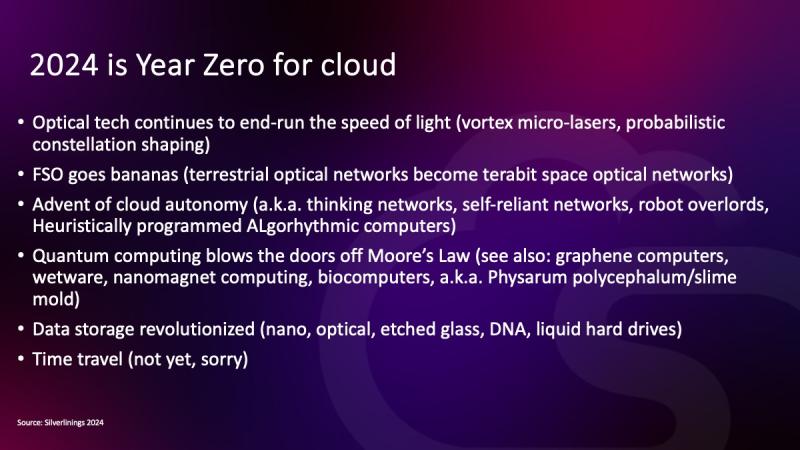-
An extraordinary wave of new technology is coming to the cloud
-
New mindsets and business models will be needed to build the cloud diaspora
-
Long-term success requires huge investments in research and development
-
2024 is year zero for cloud infrastructure
Change is nothing new to the telecom industry. Over the course of a century and a half, new technologies have arrived and disrupted the status quo – creating opportunities for some and disasters for others.
The unprecedented challenge now is the pace of these arrivals.
It took more than four decades between the invention of the telegraph (1835) and the arrival of the telephone (1876), and then nearly a century for the first data network to emerge (1969). After that, the cadence increased… a new wireless G standard every 10 years, a major network shift (IP, optical, cloud) about every two decades.
Which brings us to the here and now – a decade in which our industry is about to undergo a tidal wave of innovation of unparalleled scale, diversity and speed. From now on, it will be years, not decades, between revolutionary new technologies that will blow the doors off established business models.
There are several reasons for this acceleration – the industry's shift from hardware platforms to software in everything; The boom in communications technology in Asia; Realizing how powerful global communications opportunities are – but it is less important than understanding what is happening in the world of communications and how it will change everything.
The truth is that, as of today, we are not ready.
Tech iceberg, straight ahead!
As a Silverlinings reader, you already know about the cloud and artificial intelligence (AI) and are actively working on how to deploy them practically to drive profit and efficiency in your business (right?).
But right behind these two game-changers comes a barrage of other technologies, some of which are only now beginning to move from science fiction to scientific fact.

(Source: SilverLinings)
Some of these developments are amazing.
When I first started covering free space optics as a junior reporter in 1989, the products could transmit a 1-Mbps stream of data over a distance of a few city blocks, provided it wasn't raining.
In 2016, the German Aerospace Center demonstrated 1.72 terabits per second over a distance of 6 miles — 1.7 million times faster (yes, that's a million).
The image above provides a non-exhaustive list. From wet tools to probability constellation to nanomagnets, it's a wonderfully diverse lineup. But each of these technologies has something in common: they are designed to take a specific characteristic of communications networks and improve it by increasing network capacity/speed, making processing more robust, allowing more data to be stored, or reducing the size and power use of devices.
As such, none of these technologies are designed to replace the cloud or AI per se. Instead, they are designed to complement them – to become key components of the world's cloud communications infrastructure, which will be managed using artificial intelligence.
Obviously, not all of these technologies will go mainstream, and that's okay because there's a lot of redundancy between what they're trying to achieve.
For cloud architects, more important than picking a winner is determining what type of cloud these upgrades will enable us to build and prepare for. This, as they say, is where things get really interesting.
D days
The next generation of cloud networking will be defined by three characteristics (I managed to make them all start with the letter “D,” because I felt like it).
Distance independence
Today, international data travels over a series of fiber networks owned by different service providers. It is a complex, expensive and inefficient system. In the near future (this decade), we will begin sending data into space, where it will travel around the planet at the speed of light via constellations of satellites equipped with optical transceivers in free space, before returning to its destination on Earth.
Out of reach? never. There are three companies developing orbital optical networks: AWS, Starlink, and Laser Light Communications. (Disclosure: I work for Laser Light, which is the only one of the three that plans to use optical communications in free space all the way to the planet, rather than radio.)
These space networks will provide the same benefits for communications that space planes will provide for travel, fundamentally resetting our understanding of how long it takes for data to get from point A to point B on (and around) planet Earth.
Data equality
Space-based optical networks will eliminate the world's East-West and North-South digital divides, allowing every country in the world to participate at full speed in the global digital economy.
Imagine the impact of dropping 200 gigabits per second of capacity to Kigali in landlocked Rwanda, which currently has to send cross-border traffic to undersea fiber optic cables in Kenya and Tanzania. Now extrapolate that to the other 48 countries in sub-Saharan Africa. Change the game, change the life, change the world.
Data diaspora
Data centers are the area of today's cloud market that is set to see the most disruption in the next two decades.
Rapid advances in data processing and storage technology (smaller and faster) eliminate the need to cluster servers and storage in massive data center facilities.
Instead, expect a significant migration of compute and storage to the field, home, pocket, or pinky ring, where they form a massive data diaspora.
Data centers will not disappear completely, but there will be fewer of them, and they will be relocated. Once again, one destination is space, where near-zero temperatures make satellite data centers the ideal place to house quantum computers. Others will move to the ocean floor – which is also nice and cold – where outdated information that is less needed will live (remember hierarchical storage management? Its time has come, just three decades after it was first proposed!).
By the way, there is no human in either location. Frozen, hermetically sealed, and managed by robots – this is the future of data centers that survive the migration to the data diaspora.
The paradox of time
There is a time paradox at the heart of today's innovation cycle. As the time lag between the arrival of new, game-changing technologies decreases, the length of time ahead that potential users and technology vendors need to plan increases or else they run the risk of building a legacy network before it is ready for use. Even lit.
Are providers and vendors doing this now? Not nearly enough.
In the United States, most of the good work in North American high technology is done in academia (kudos, nerds).
What is needed is a group of industry players with extensive experience in spying on promising new technologies, commercializing them, and making the technology available through patent licensing to everyone (even their competitors).
In other words, telecom vendors.
Building for the future
Building for the future is problematic for existing vendors, who are accustomed to focusing on the next fiscal quarter or year.
Instead, they must evolve into the communications world 10 or 20 years from now, and build and monetize it before their competitors.
This requires huge investments in research and development, which is not compatible with their current business models.
Cisco spent about $7.6 billion on R&D in 2023, or 13.33% of its $57 billion in revenue. It is also 65% profitable. To become a competitive force in the coming cloud world, a company needs to sacrifice huge profits in order to invest deeper in R&D, and it can certainly afford to do so. But it won't, because it's not chasing success anymore (it left its culture of disruptive innovation next to Route 101 sometime in the last decade) and is now entirely beholden to its shareholders and Wall Street.
Meanwhile, Ericsson and Nokia each spent about 17% of their revenue on R&D in 2022, or $4.6 billion and $4.9 billion respectively, numbers that are unlikely to rise much given their current financial situation. However, they spent more than Deutsche Telekom, which says it spent $33 million on R&D on revenues of $125 billion (or 0.02%….actually haha for German investors!).
Currently, the only global company that has focused on the R&D imperative is Huawei, which spent 25% of its revenue in 2022, or about $25 billion, which is another reason why Huawei should give its Western competitors a chance.
The best way for vendors and cloud architects to approach the challenge of new technologies is to look at 2024 as year zero for cloud infrastructure… Ditch the old thinking and bring in the new. or not. The Chinese are already doing this, and if that sounds great to you, why, just sit back and enjoy the new cloud world.
Read more opinion pieces by Steve Saunders here.

